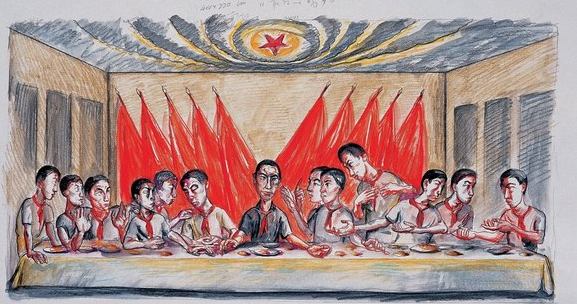
According to Andy Warhol, “pop art was liking things”. Mind you, that was in 1963, a bad year for facts, particularly at the Factory, Warhol’s Bacofoil-lined pleasure-ground-cum-studio in Manhattan, where people were stabbing syringes into their backsides, and corridors were places in which to film blow jobs. In 1963, no one at the Factory was certain if he was a she, let alone what constituted pop art.
Interestingly, the term was coined in Britain by the Scottish sociologist John McHale, in 1954. A punchy shortening of popular art, it was our name, not theirs. Britain in the 1950s was, of course, a very different place to America in the 1960s. Over there, they had on tap all the stuff pop artists liked to paint — Coke, hot dogs, pin-ups, Cadillacs, Marilyn, Elvis. Over here, we could only dream of them. British pop art wasn’t about liking things. It was about wanting them. Wanting them bad. So although pop art features things that everyone immediately recognises — famous brands, famous faces, popular goodies — the reason for putting them in a painting changes, as you will see when you visit Post Pop: East Meets West, a selection of international pop art heading for the Saatchi Gallery.
The Saatchi show is about what happened to pop art when it turned up in places like China and Russia, and changed tack. In Beijing in the 1980s, pop art definitely wasn’t about liking things. Take Chairman Mao. One of the first shows I saw at the Saatchi Gallery had a spectacular portrait of Mao by Warhol hanging at the end of its opening vista. It was gigantic: Mao as the Chinese Elvis, a floor-to-ceiling face that everyone recognised instantly, smiling at us as we entered the gallery. Warhol was a political klutz, with zero sense of humanitarian responsibility. He didn’t care about the Cultural Revolution or the Gang of Four. He was merely pointing out that the famous image of Mao was a fab piece of design that looked really great when you blew it up to wall size. Wow. Gee. Will you look at that.
Wind the clock forward a couple of decades, though, to Ai Weiwei, and you see a very different response to the smiling face of Mao. In Weiwei’s pictures, an anonymous Chinese hand is giving the Chairman the finger. In his most notorious pop image, he persuaded his wife to lift her skirt in Tiananmen Square and flash her knickers at the portrait of Mao that hangs outside the Forbidden City. When pop art arrived in China, it wasn’t about liking things. It was about hating them. About destruction. Repression. Mind control.
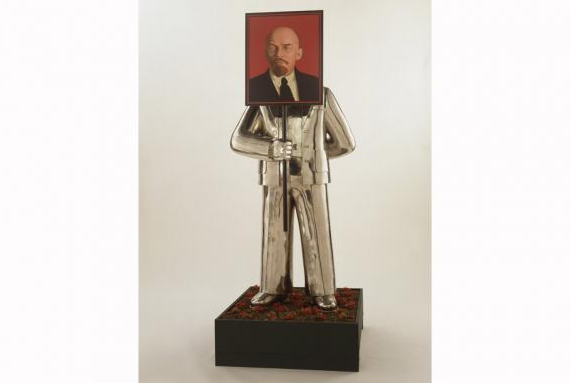
More recently, the weird amalgam of Wall Street methods and party rulings that is propelling China forward has been confusing the hell out of its artists. Chinese political pop has been asking: are we communists now, or capitalists? In a typical Wang Guangji painting, a bunch of heroic Red Guards will be surging forwards and shouting, in perfect unison, that great revolutionary slogan: “Porsche”. Or maybe “Chanel”. And to work out exactly what Yu Youhan is trying to argue in his doubly confusing Self-Portrait as Warhol’s Portrait of Mao, you obviously require a Confucian background substantially more profound than mine.
Humour, of the sarky variety, has always played its part in pop art. However, when it comes to political grinning, the Chinese are no match for the other big international players in the Saatchi show — the Russians. In Russia, being sarcastic is a national birthright. I mean, who knows for sure what Leonid Sokov wanted us to think when he combined a brass portrait of Stalin with a smiling photo of Marilyn Monroe? Who is being mocked here? The commies or the Yanks? Both at once, I reckon. The Russians for coming up with Stalin. The Americans for coming up with Marilyn.
Sokov was part of a Russian post-pop movement known as Sots art, or Soviet pop art. Started in the 1970s, when Leonid Brezhnev was general secretary, Sots art was massively adept at being sarky. The two artists who gave the movement its name, Vitaly Komar and Alexander Melamid, had both worked in the Soviet propaganda industry. They were admen, like Saatchi himself, with an instinctive grasp of the power of the image. Legend has it that while planning a campaign for a Young Pioneers summer camp, Komar and Melamid decided to put themselves and their wives into the pictures, thereby sending up the pioneers, while simultaneously inventing Sots art.
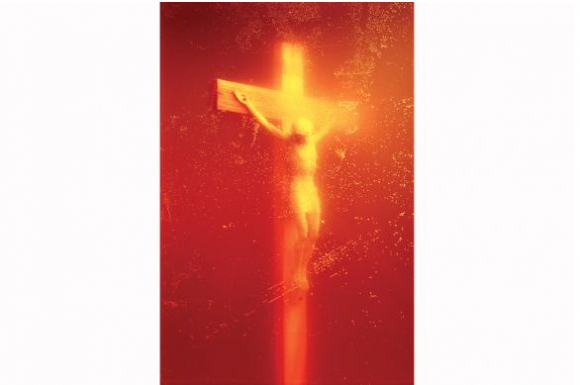
Something else worth noting here is the tremendous age of these artists. Sokov is 73. Ilya Kabakov, the so-called grandfather of Russian pop, is now 81. Komar is 71. Melamid is 69. Alexander Kosolapov, to my eyes the most brilliant of the Sots artists, is also 71.
And it isn’t only the Russians who are of a venerable Pop vintage. Li Shan, another habitual Chinese reuser of Chairman Mao’s image, is 72. Yu Youhan is 71 again. Wang Guangyi was born in 1957, as was Ai Weiwei. Add them all up and it constitutes a gigantic amount of wisdom, sarcasm and life experience. The Saatchi show includes updates, as well, on assorted artists from the West who have taken pop art into its (gulp!) seventh decade. Michael Craig-Martin, Britain’s go-to artist when it comes to painting the foyers of embassies, is 73. And I was genuinely shocked to find that Andres Serrano, producer of the most controversial of all bits of alternative pop from the 1980s, the particularly infamous Piss Christ, was born as long ago as 1950. So Andy was wrong. Pop art isn’t about liking things. It’s about surviving them.
Leonid Sokov 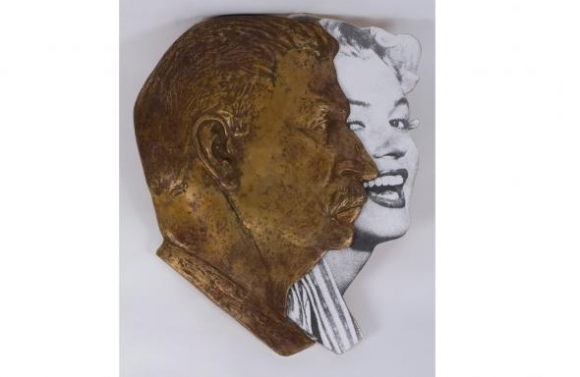
In common with his fellow Russian Alexander Kosolapov, Leonid Sokov made New York his home decades ago. East collides with West in his work, resulting in the likes of his piece depicting a hammer and sickle crafted into a dollar sign, and his Saatchi exhibit (above), a bronze portrait of Stalin alongside an image of Marilyn Monroe. “Pop art for me is an American moment in the 1950s and 1960s. It was a very strong moment — it had a big impact on the last century. Many Russian artists of my generation were inspired by it,” he says. Their work became known as Soviet pop art, or Sots art. He was drawn to Stalin, a man he describes as “charismatic”, because he was an important figure for the people in the Soviet Union and Russia. He believes the initial pop art moment was sparked by America’s need to express its nationality after the war.
Alexander Kosolapov 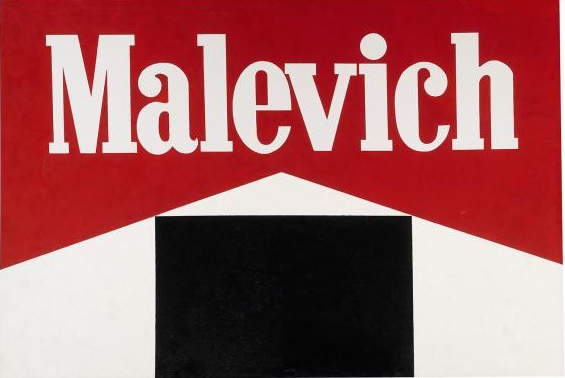
Kosolapov’s Marlboro, Malevich series tackles the subjects of art history and our consumer culture. This image re-creates the instantly recognisable cigarette packet, substituting the word Marlboro for Malevich — a reference to the Russian artist Kazimir Malevich.
When he emigrated from Moscow to New York in the 1970s, Kosolapov saw plenty of similarities between the two cities, despite living through the Cold War era. He started to compare “the social icons of the two countries” and found himself marrying images of communist ideology with products of western mass culture — cue his profile of Lenin with the Coca-Cola logo.
Eleven of his works appear in the Saatchi exhibition, including his 2007 bronze sculpture Hero, Leader, God, depicting Lenin and Christ hand in hand with Mickey Mouse.
Kosolapov fully embraced the notion of pop art as revolutionary from a young age: “I approached it as a kind of mockery, and started to criticise those small groups who were in power and were ignoring human issues.” The Muscovite’s cheeky use of religious symbols, including a doleful-eyed Christ alongside the McDonald’s logo, outraged the Russian church.
Although inspired by Russian culture, Kosolapov despairs of his homeland’s autocratic society, and of Vladimir Putin, whom he calls “cynical”.
“I had illusions in 2000 that Russia could be a more open society and I started to work with Russian curators, but that turned out to be a delusion and the situation is the same today,” he says. Despite creating so much art, he’s no collector, preferring to line his walls with books instead.
Michael Craig-Martin

The Irish artist Craig-Martin is attracted to everyday objects, owing to the universal role they play in our lives: “The objects we surround ourselves with are more descriptive of us and our values. They transcend differences in language and culture.”
His bold, colourful pictures have been described as pop art, but he’s dismissive of attempts to shoehorn his work into this category. “One of the most essential aspects of pop art was that the artist made images of existing images — Warhol used advertising, and with Lichtenstein you get comic books. I rarely make images of images. The things that interest me are objects and transforming [them] into images, which is not a pop interest.”
In the 1970s and 1980s he worked as a tutor at Goldsmiths College, and had a keen influence on the YBA generation. He’s still close to many of them, including Damien Hirst, Gary Hume and Sarah Lucas. Although he’s proud of their success, he isn’t convinced the eye-watering prices their work commands will hold up. “It’s a cycle. It won’t last for ever. People forget that there was an artist called Augustus John, who was the David Hockney of his day, the most famous artist in Britain. Today, few people even know who he is. This is a strange period in art.”
Craig-Martin prefers to work without help. “I have no idea how anybody copes with this. Damien can at least afford to manage the people who work with him. People management is not how I wish to spend my time. It’s much more distracting than doing things myself — I’m from a DIY generation.”
Gu Wenda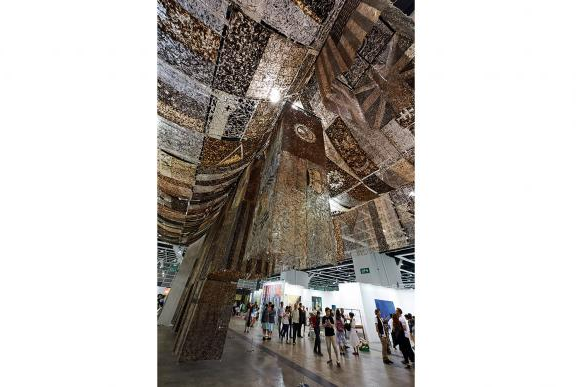
No material is off limits for the Chinese artist Gu Wenda, who uses hair, semen, sanitary towels and placentas in his work. “I want to find unusual materials to be different from others. My main aim is not to shock, rather to be thought-provoking,” he says.
Gu started working with human hair 20 years ago for his worldwide art project, United Nations. Visitors to the Saatchi Gallery will see one element of this work, a wall of national flags made partly from the tresses of more than 4m people. Some of the museums in which he exhibits help to collect hair from salons, but this installation will contain no samples from the local Chelsea set.
“My work is inclusive of everyone,” he says. “People have been very positive. Even if they just see a picture of the work, their hair starts to feel itchy. It’s a very strange subject matter. The visual impact is powerful and beautiful.”
Gu regards his work as an extension of pop art. “Pop art is usually iconic images, popular subject matter, most people can appreciate it and be involved with it. Pop art offers easy access for all. My approach is to use a popular medium — human hair.” When Wenda was starting out as an artist in Shanghai, his parents were concerned about the attention his contemporary work was attracting. “Before I came to America, they worried about me because I was a rebellious and controversial figure in China and this caused me trouble,” Gu says.
He had no opportunity to show in a public space, as all the museums were government owned. “My big splash came in 1986, the year I had my first show. It was forced to close before it even opened.” Now that his work sells for between $150,000 and $2.5m, his parents have changed their minds. “They feel that what I did was right. I’m the most successful person in the family.”
